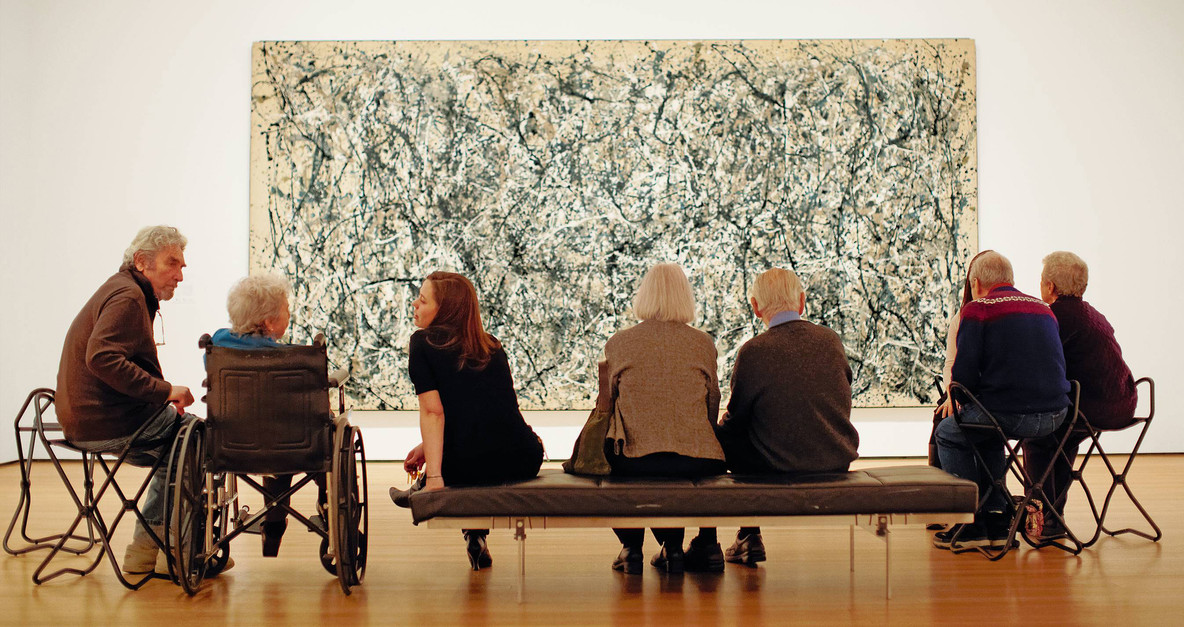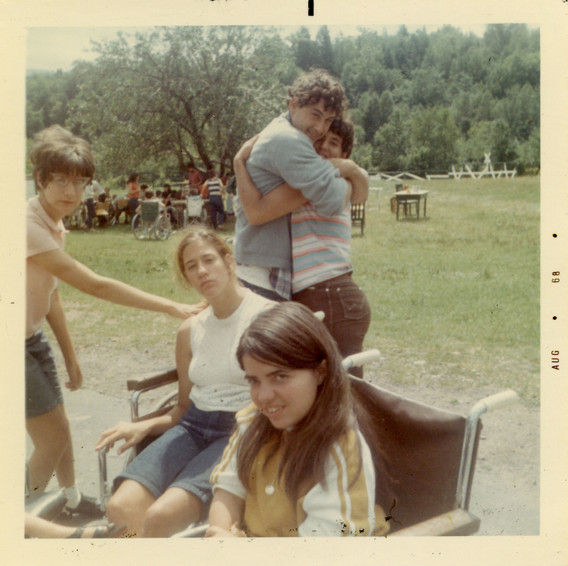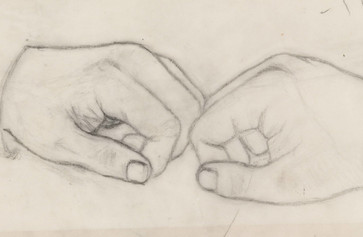Working for Disability Equality
An incomplete list of resources, organizations, and voices supporting equity, access, and inclusion
Jul 24, 2020
In commemoration of the 30th anniversary of the Americans with Disabilities Act on July 26, and in conjunction with the release of our Disability Equality and Museums Series, a cross-departmental group of MoMA staff compiled this evolving list of disability resources.
Perspectives on disability equality
Access Champions Podcast
A podcast with interviews with Access Champions and Inclusion Warriors from around the world
The Accessible Stall
A disability podcast that keeps it real about issues within the disability community
The Disability Visibility Project
An online community dedicated to creating, sharing, and amplifying disability media and culture
Enhance the UK
Enhance the UK is a charity run by disabled people. We are passionate about the society we live in, and want to change the way disability is viewed for the better.
MoMA’s Disability Equality and Museums Series
In this video series, you’ll hear firsthand from New Yorkers about their experiences and perspectives on disability equality.
Understanding the Social Model of Disability
The social model of disability is a way of viewing the world, developed by disabled people.
Ouch: Disability Talks (BBC Sounds)
The place where the real disability talk happens. Interviews, life hacks, and things you don't say out loud
Rooted in Rights
We’re here to challenge the status quo, pushing readers and writers alike to think beyond the tired tropes of disability. The Rooted in Rights Blog publishes pieces that share perspectives on disability, amplify key issues and ideas, and make it known loud and clear that disability rights are human rights.
TEDTalks
Judith Heumann: “Our Fight for Disability Rights—And Why We’re Not Done Yet”
Stella Young: “I’m Not Your Inspiration, Thank You Very Much”
Unpacking Disability
The place where disability is unpacked and shared, and where people are empowered. This is a community by and for disability, and you can expect reviews, resources, lots of opinions and perspectives.
Resources for artists with disabilities
Careers in the Arts for People with Disabilities
The National Endowment for the Arts seeks to address barriers and advance training and career opportunities in the arts for individuals with disabilities.
Creativity Explored’s list of art and disability organizations
Here are some links to organizations providing opportunities for adults with disabilities to express themselves through the creation of art in the US and around the world.
Disability Arts International
A database of organisations and umbrella bodies linked to the work of disabled artists
The Haven Foundation
The mission of The Haven Foundation is to offer interim financial assistance to freelance professionals in the arts who have experienced a recent, unforeseen emergency or triggering event that has significantly and adversely affected the qualified person’s ability to produce, perform, and/or market his/her work.
Leeway Foundation’s “Resources for Inclusion of People with Disabilities in the Arts”
Lester Petrillo Memorial Fund for Disabled Musicians (American Federation of Musicians)
A charitable trust fund that provides financial aid to disabled members.
Resources for museums
ADA Design Standards
Design Standards issued by the US Department of Justice in 2012, as a corollary to the revised ADA of 2010. The standards are primarily architectural. Museums are included as Public Accommodations, Title III.
Chicago Cultural Accessibility Consortium’s (CCAC) Resources List
Helpful links to learn more about cultural accessibility and inclusion
“For Caregivers: A Guide for Connecting Creatively”
Ideas and prompts in English and Spanish that support communication and wellness through art

Older adults take in a Jackson Pollock during a MoMA Access Program. From “For Caregivers: A Guide for Connecting Creatively.” Image description: In a gallery, a group of seven adults sits with their backs to the camera, in front of a large abstract painting. Most of the adults have gray hair. One adult with long light brown hair is turned to the left, speaking to a gray-haired individual in a wheelchair. In the background, the painting, so large it is only partially visible, features arcing spatters of black, white, and gray paint.
Leadership Exchange in Arts and Disability
A professional network focused on expanding the breadth and scope of accessibility services and programming across the country and around the world.
The MoMA Alzheimer’s Project: Making Art Accessible to People with Dementia
Resources for engaging with art with individuals with dementia
Museum Arts Culture Access Consortium (MAC) Resources List
MAC is an organization striving toward increasing access to NYC’s cultural institutions for the disability community and sharing resources for cultural professionals to use to provide more accessible spaces and programs for people with disabilities.
Smithsonian Standards and Guidelines for Accessibility and Accessible Exhibition Design
Guidelines for creating accessible spaces and exhibitions
Films
Crip Camp
Available on Netflix
A groundbreaking summer camp galvanizes a group of teens with disabilities to help build a movement, forging a new path toward greater equality. Read more about Crip Camp and watch discussions from the film’s New York premiere
Wretches and Jabberers
Available on kanopy and Vimeo
This documentary chronicles the world travels of disability rights advocates Tracy Thresher and Larry Bissonnette, in a bold quest to change attitudes about the intelligence and abilities of people with autism.

Crip Camp. 2019. USA. Directed by Nicole Newnham, Jim LeBrecht. Image description: Several young adults gather in a grassy outdoor space. In the foreground, two people seated in wheelchairs look directly at the camera. A third stands to the left, one outstretched hand touching the back of one of the wheelchairs. Behind these three, two more young people stand in a tight embrace, grinning. In the distance, a larger group of people is gathered together below a tree.
Suggestions for further reading
Cachia, Amanda. “‘Disabling’ the Museum: Curator as Infrastructural Activist.” Journal of Visual Art Practice 12, no. 3 (2013).
Readings on Race and Disability (from Black, Disabled, and Proud: College Students with Disabilities)
This list is not complete and includes a variety of readings related to race and disability, with an emphasis on education and universal design teaching resources for faculty. The list is meant to serve as a starting point for those interested in these topics.
“What Does It Mean to Be an Accessible Museum?”
“Where to Donate to Help Black People with Disabilities”
Sandell, R., Dodd, J. and Garland-Thomson, R. Re-Presenting Disability: Activism and Agency in the Museum. Routledge, 2013.
Guffey, Elizabeth. Designing Disability: Symbols, Space, and Society. Bloomsbury, 2017.
Kleege, Georgina. More Than Meets the Eye: What Blindness Brings to Art. Yale University Press, 1999.
Williamson, Bess. Accessible America: A History of Disability and Design. NYU Press, 2019.
Wood, Caitlin. (Ed). *Criptiques. May Day Publishing, 2014.
Gilbert, Regine. Inclusive Design for a Digital World: Designing with Accessibility in Mind. Apress Publishing, 2019.
Thanks to Francesca Rosenberg, Carrie McGee, Sean Anderson, and Josh Siegel for their work in compiling these resources.
Related articles
-

Resources
A Place to Start
An incomplete list of resources and organizations for fighting racism and supporting justice and equality
Jun 3, 2020
-

Resources
Mutual Aid by and for Artists
We’ve compiled a brief list of grants, counsel, and care resources for artists during the COVID-19 crisis.
Apr 28, 2020

